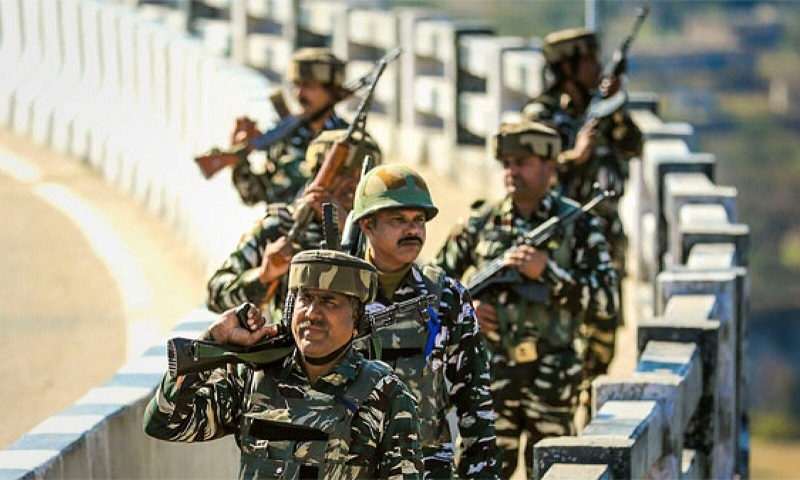If the security situation in Manipur is becoming even murkier, then the only way out is for the principals to come together into a huddle and ferret out a way for immediate course correction.
But before the write-up, the primary consumer of which is expected to be New Delhi, mulls over one important aspect by way of a single point recommendation, it wishes to put into perspective three incidents that have occurred very recently in Manipur which have left a bad taste in every right thinking palate.
The first pertains to the manner in which miscreants set off IED blasts on a crucial bridge on NH-2 in Manipur’s Kangpokpi district. The bridge connects Imphal with Nagaland’s Dimapur. The incident occurred on April 24, and just two days ahead of the second phase of polls in the strife-torn state.
The highway is the major lifeline of the state and its severance has led to the stranding of over 100 trucks carrying essential supplies for the people of Manipur. The highway is a major lifeline for Manipur.
The other incident is about the manner in which two CRPF personnel in Naranseina in Manipur’s Bishnupur district was killed by miscreants.
The killing of the CRPF personnel is unusual. It is the considered opinion of this conflict theorist that the action (despite the fact that the perpetrators were very well trained terror actors) could well have been an inadvertent one.
It is important to take into consideration a few aspects by way of possibilities and reverse investigation.
An Indian Reserve Battalion (IRBN) was located about 200 metres away from the area where the CRPF were billeted.
The IR Bn personnel were primarily from that of the Meitei community. The time of the attack was between midnight and 2:15 AM on 27 April 2024.
It has also been reported that the CRPF were in the process of vacating the camp in Naranseina and only a platoon strength had been left behind.
The incident poses two possibilities.
One is that miscreants thought that they were targeting the Meitei elements of the IRBN and as the timing of the attack was in the dark of the night, it cannot be ruled out that they mistook the CRPF camp for the IRBN one. The unfortunate casualties were, therefore, the two CRPF personnel.
However, yet another theory could well be that the target was actually the CRPF. The reason proffered is a page out of the United Liberation Front of Asom’s (ULFA) modus operandi during the mid 1990s when the insurgent group went on a killing spree of Hindi-speaking people of Assam.
Such a stratagem was adopted by the ULFA in order to attract the “attention of New Delhi” which indeed it was successful in so doing.
This conflict theorist clearly recalls a write-up which he had titled as “Mails by Bombings” at the time.
A slew of MPs from Uttar Pradesh and Bihar had descended on Assam of the day to provide succour to their Hindi-speaking brethren.
The ULFA had achieved two aspects. One it had “attracted” the attention of New Delhi and secondly it had left unscathed the hypocritical stance of what it then thought was its parish, the Assamese people.
For there was (and continues to be!) a section of people among the Assamese population who are against outsiders from setting up shop in Assam.
As an aside, it would be of interest for readers to note that the ULFA never attacked a single illegal Bangladeshi migrant in its dubious history.
Any student of history would know that ULFA came into existence as a militant manifestation of the students’ agitation against illegal migration from Bangladesh.
But it reneged on its founding principles immediately after, especially when anti-India powers in the erstwhile East Pakistan provided it safe havens in Bangladesh.
But, to return to Naranseina, the possibility that the miscreants had deliberately targetted CRPF could well be yet another instance of “Mails by Bombings”.
After all, the lawlessness in Manipur has sunk so deep that there are elements who are beginning to feel that New Delhi needs to be taught a lesson.
It is important to note that central paramilitary forces such as the CRPF and the BSF had not been targeted in the past.
Readers will note that this conflict theorist has stopped short of naming any organisation for both the aforementioned acts.
The first finger of suspicion for both the IED explosion on the bridge on NH-2 and the attack on the CRPF were on Kuki militants.
But in present day Manipur, the atmospherics are such that it could well have been anybody.
In a state that has been careening out of control since 3 May 2023, the battleground that Manipur has been converted into, almost everyone has become militarised.
The third incident pertains to a continuing state of anarchy that has clear political patronage.
Mera Paibis waylaid an Indian army Caspir after the column had apprehended cadres of the Arombai Tenggol with illegal weaponry. This conflict theorist has seen the live video of the incident.
Hundreds of Mera Paibis had surrounded the Caspir and were berating the brave soldiers and their even braver Commanding Officer (CO).
A reverent salute goes out to bravehearts of the Indian army for their restraint.
For if the CO had lost his composure, there could well have been a bloodbath. But these are the sort of situation that the Indian army has trained its officers and men for, and the incident of April 30 speaks volumes about the leadership as it directs it’s troops from Rangapahar (Dimapur) and Fort William (Kolkata).
In sum, this conflict theorist whose aged countenance has witnessed conflict after conflict in the North East since 1993 and has tried to find not only explanations for the continuing malaise, but solutions as well, wishes to, at this juncture, make one pointed recommendation.
It is a happy feeling when he recalls his association with Generals R.K. Sawhney, N.C.Vij and B.K. Bopanna.
The present Eastern Army Commander was a Commanding Officer in Lower Assam at the time, and this conflict theorist fondly recalls spending many an evening with him when the latter was the Adviser (CI Ops) to the Government of Assam, or when the then CO of a Goalpara based Kumaon Regiment would come to 21 Mountain Division to listen to this Conflict Theorist speak about CI-CT, psychological initiative and Human Rights.
Assam has ushered in peace as a result of well-honed team work. Therefore the recommendations at this time is that a Unified Command Structure (as was the case in Assam) must be immediately formed for Manipur, Nagaland and South Arunachal Pradesh.
It should be under the overall command of the General Officer Commanding of the Rangapahar based 3 Corps. It is the need of the hour.
There must be one clear voice (naturally after due consultation) that should focus on strategy and ways and means for sanity to return. Manipur would be irreparably lost if the present imbroglio is allowed to continue.
The Indian state and its noble army are powerful entities. It can face any challenge.
The only move that New Delhi needs to understand and undertake at this critical juncture is to empower its arms.
The Indian army, as the Assam experience has shown, is more than capable of achieving the impossible.
The blessed countrymen are with the intrepid force Mar Te Dam Tak.
(Jaideep Saikia is an internationally renowned and acclaimed conflict theorist and best selling author)















